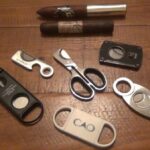To address minor tears in the outer leaf of your premium hand-rolled smokes, consider using vegetable-based adhesive. Apply a small amount to both edges of the rip, gently pressing them together. This method preserves the integrity of the wrapper without compromising flavor.
If the damage is more extensive, a small piece of corresponding wrapper can serve as a patch. Cut a fragment from a less desirable stogie or a leftover leaf, ensuring it matches in color and texture. Attach it with the same adhesive, blending it carefully with the original leaf for a seamless appearance.
Humidity control is paramount when handling such delicate materials. A humidor set between 65-70% RH will keep the tobacco supple, reducing the risk of further damage. Regularly monitoring moisture levels ensures optimal preservation of your collection.
Another innovative approach involves using food-grade vegetable oil. When lightly applied to the damaged area, it rejuvenates the leaf’s appearance, masking imperfections while adding a layer of protection against external elements.
Monitoring storage conditions and maintaining stability in moisture levels will significantly enhance durability. Always enhance your experience by practicing gentle handling techniques during storage and light-ups, ensuring your cherished collection remains exquisite.
Identifying the Cause of Cigar Wrapper Cracks
Inspect humidity levels in the storage environment. Fluctuating moisture can lead to dehydration or over-saturation, causing the outer leaf to split. Maintain a consistent humidity level between 65% and 72% for optimal conditions.
Evaluate temperature control. High heat can dry out tobacco, making it brittle. Aim to keep temperatures between 68°F and 72°F to preserve wrapper integrity.
Examine handling practices. Rough or careless manipulation can result in unintended damage. Always hold cigars by the body, avoiding pressure on the delicate outer layer.
Look for signs of pest infestations. Insects can create stress points or small holes that compromise the structure. Regularly inspect cigars for unwanted pests and take preventive measures.
Consider the quality of the leaves used. Poorly constructed wrappers or those made from low-grade tobacco are more prone to damage. Source from reputable manufacturers to ensure high-quality materials.
Be aware of transportation conditions. Sudden changes in environment during shipping can cause stress to cigars. Ensure proper packaging and handling to minimize risk during transit.
Analyze aging techniques. Improper aging can affect moisture retention and flexibility. Store cigars in a controlled environment for the appropriate length of time to ensure robust health of the outer leaves.
Materials Required for Wrapper Repair
To address issues with the outer leaf of your tobacco sticks, gather the following items:
Quality Adhesive: Use a blend of food-safe glue or plant-based adhesive that ensures a secure bond without altering flavor. Options include organic tree gum or specific cigar adhesives.
Thin Leaf Material: Source replacement leaf from similar tobacco types. It should match in texture, humidity, and color to blend seamlessly. Consider purchasing bundles from reputable suppliers.
Scissors or Sharp Blade: Maintain precision with a sharp tool to trim any damaged sections cleanly. Scissors are preferred for thin leaves, while a craft blade works well for detailed cuts.
Humidity Gauge: A hygrometer helps monitor moisture levels in the storage environment, ensuring that repaired sticks maintain proper humidity.
Moistening Agent: Keep the replacement leaf pliable with distilled water or a mixture of water and vinegar in a spray bottle. A small sponge can also aid in application.
Soft Cloth or Brush: Utilize a soft cloth or brush to apply adhesive evenly, minimizing the risk of disrupting the integrity of the surrounding leaf.
Small Weights or Clips: Use these to hold the repaired area in place while the adhesive dries, ensuring a strong bond.
Gathering these items will facilitate a successful restoration process, enhancing the overall quality of your fine tobacco products.
Step-by-Step Guide to Repairing Cracked Wrappers
Begin with a clean workspace. Gather necessary items: a humidifier, glue, and a damp cloth. Ensure the environment is suitable, maintaining consistent humidity to prevent further damage.
Assessment
Examine the leaf closely to identify the size and nature of the fissure. Note if the damage runs along the seam or is isolated to a specific section. This informs the subsequent approach.
Application Process
Apply a small amount of glue, preferably one designed for tobacco leaves, directly onto the crack using a toothpick or small brush. Carefully press the edges together. Dampen the cloth slightly and place it over the area to create a seal. Allow it to set for approximately 30 minutes. Remove the cloth and inspect the adhesion. If necessary, repeat the application to reinforce the bond.
Store the item in a controlled humidity environment for 24 hours to ensure stability before consumption.
How to Maintain Moisture Levels During Repair
Keep the environment at a consistent humidity level of around 65-70% to prevent drying out the leaf during the maintenance process.
- Use a humidor with a calibrated hygrometer for accurate readings.
- Periodically check moisture levels before and during the fixing process.
- Consider utilizing distilled water or specially designed humidity beads to maintain moisture without introducing impurities.
Applying a light mist of distilled water on the outer layer can help maintain hydration.
- Ensure that the mist is fine to avoid excess moisture on one area.
- Allow the leaf to acclimate for several hours afterward.
Wrap the item in a damp cloth for short durations to add moisture without saturation.
- Do not leave it wrapped for an extended period, as excessive moisture can lead to decay.
- Check periodically for any signs of dampness to avoid over-saturation.
After completing the restoration process, place the item back in the humidor to let it stabilize at desired moisture levels.
Evaluating the Quality of Repaired Wrappers
Examine the texture of the leaf closely. A quality fix will maintain the original feel, ensuring it remains smooth and pliable. Any roughness or stiffness indicates subpar work.
Visual Inspection
Inspect the color consistency across the surface. A visually appealing finish reflects skilled handling. Patch jobs should blend seamlessly with the surrounding material, without obvious lines or discoloration.
Burn Test
Conduct a burn test by lighting the end of the smoke. Observe the burn rate and flavor. An adequately restored leaf should burn evenly, without relighting issues or an altered taste profile. Uneven burning signals underlying flaws.
Check how the leaf interacts with humidity. Quality repairs will retain moisture without excessive dryness or peeling. Proper humidity retention indicates effective sealing during the mending process.
Combine these methods for an accurate assessment. A superior patch will uphold the integrity of the experience, allowing enjoyment without distraction.
Preventive Measures to Avoid Future Cracks
Maintain consistent humidity levels between 65-70% to ensure optimal moisture retention in the outer layer. Use a quality hygrometer to monitor conditions in storage environments. Rapid fluctuations can lead to physical damage.
Proper Storage Solutions
Store in a humidor designed for adequate air circulation. Avoid overcrowding; allowing space enhances airflow and prevents moisture buildup. Select cedar-lined options, as cedar helps to regulate humidity naturally.
Handling Practices
Handle smokes delicately, avoiding excessive pressure while rolling. Use a soft, lint-free cloth for cleaning to avoid abrasion. Avoid extreme temperatures or direct sunlight exposure, as both can weaken the exterior.
Q&A: Repair cracked flaking cigar wrappers
What should you do if the wrapper leaf on your cigar starts to crack before you light your cigar?
If the cigar’s wrapper begins to crack, especially at the foot of the cigar, one quick fix is to use a small piece of wrapper leaf from a less expensive cigar and reapplying it using pectin. This method helps to repair a cracked wrapper leaf and seals the damaged wrapper in place before you smoke a cigar.
How can pectin help repair a cigar with a cracked wrapper?
Pectin is a natural adhesive that cigar enthusiasts use to repair a cracked cigar wrapper without affecting the taste. Applying a bit of pectin to the damaged wrapper and pressing it gently can fix a cracked cigar, especially when the crack is in a single spot or along the edge of the wrapper.
What’s a reliable way to fix a cracked wrapper on a rare cigar without using glue?
A good way to repair a cracked wrapper leaf on a rare cigar is to take a small piece of wrapper leaf from another cigar and use pectin or even saliva to seal the wrapper back. As the saliva dries and the wrapper leaf settles, the crack becomes less noticeable, allowing you to enjoy your cigar with minimal impact on flavor.
Why is it important to repair a damaged wrapper before you light your cigar?
Repairing a cracked or damaged wrapper before you light your cigar is essential because once heat is applied, the wrapper leaf will continue to come apart. Using cigar glue or pectin helps ensure the wrapper stays in place, preventing unraveling and helping cigar smokers enjoy their premium cigar without distraction.
What is one effective method for cigar repair when dealing with a damaged wrapper leaf on a rare cigar?
If you’re dealing with a rare cigar with a damaged wrapper, a reliable fix is to take a bit of wrapper leaf from a less expensive cigar and reapply it to the cigar using pectin. This allows you to seal the wrapper back in place without compromising the flavor or construction of the special cigar.
How can a cigar cutter contribute to wrapper issues, and how do you prevent it?
A cigar cutter can crack the wrapper leaf if used improperly, especially with delicate wrappers like cameroon and indonesian wrappers. To prevent this, cigar lovers should use a sharp cutter and make a clean cut just above the shoulder of the cap to avoid tearing the wrapper on your cigar.
What’s a quick fix if the wrapper on your cigar begins flaking apart or cracking in a single spot?
For a cigar that’s flaking apart or cracked in a single spot, one quick fix is to lick a cracked wrapper lightly or apply a small amount of pectin to hold the wrapper back in place. Let it dry completely before smoking to ensure the wrapper stays intact during the draw.
How can you deal with an unraveling cigar wrapper during a special occasion smoke?
When a cigar wrapper begins unraveling during a special occasion, a good chance you can fix it involves gently pressing the wrapper back with a dab of cigar glue or pectin. This method is especially useful for cigar enthusiasts looking to salvage a cigar with a damaged wrapper and enjoy their smoke without needing a replacement.
What is the best way to fix a cigar that is cracked in the middle without ruining the smoke?
If a cigar is cracked in the middle, a quick fix involves using a small amount of pectin or cigar glue to seal the part of the wrapper that is damaged. This method is ideal for a special occasion because the wrapper is still mostly intact, and it allows the smoker to enjoy the cigar without needing to discard it.
How can a cigar smoker deal with unraveling wrappers when taking a cigar from their humidor?
Unraveling wrappers can occur when the cigar is missing proper humidity or has been handled roughly. A good way to deal with cracked or unraveling wrappers is to apply a bit of leaf repair or gently press the wrapper back into place with clean fingers. Keeping your cigars at the correct humidity helps prevent many cigar wrapper issues from occurring in the first place.






